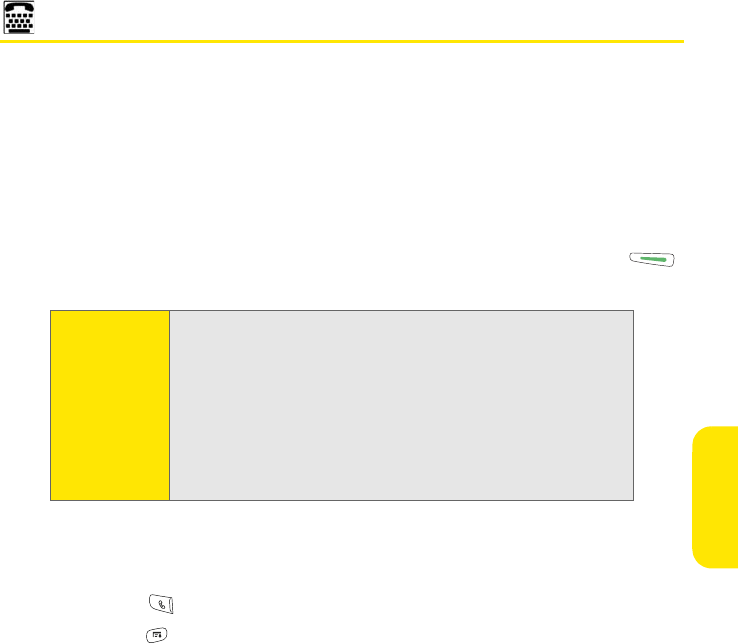Palm 895 PDA Phone with CDMA 2000 /1xEVDO and Bluetooth User Manual Sprint FM Online Guide CTIA 3b
Palm Inc PDA Phone with CDMA 2000 /1xEVDO and Bluetooth Sprint FM Online Guide CTIA 3b
Palm >
User Manual

Important Safety Information 99
Safety
Important Safety Information
In This Section
⽧General Precautions
⽧Maintaining Safe Use of and Access to Your Device
⽧Using Your Phone With a Hearing Aid Device
⽧TTY Use With Sprint Service
⽧Caring for the Battery
⽧Radiofrequency (RF) Energy
⽧Static Electricity, ESD, and Your Device
⽧Owner’s Record
⽧User’s Guide Proprietary Notice
This guide contains important operational and safety information that will help you safely use
your Sprint Power VisionSM smart device Treo™ 755p by Palm. Failure to read and follow the
information provided in this guide may result in serious bodily injury, death, or property
damage.

100 Important Safety Information
General Precautions
There are several simple guidelines to operating your device properly and maintaining safe,
satisfactory service.
䢇Speak directly into the microphone.
䢇Avoid exposing your device and accessories to rain or liquid spills. If your device does
get wet, immediately turn the power off and remove the battery.
䢇Although your device is quite sturdy, it is a complex piece of equipment and can be
broken. Avoid dropping, hitting, bending, or sitting on it.
䢇Any changes or modifications to your device not expressly approved in this document
could void your warranty for this equipment and void your authority to operate this
equipment.
Note: For the best care of your device, you must allow only Sprint authorized
personnel to service your device and accessories. Failure to do so may be
dangerous and void your warranty.

Important Safety Information 101
Safety
Maintaining Safe Use of and Access to Your Device
Do Not Rely on Your Device’s Phone for Emergency Calls
Wireless phones such as the one on your Treo device operate using radio signals, which
cannot guarantee connection in all conditions. Therefore you should never rely solely upon
any wireless phone for essential communication (for example, medical emergencies).
Emergency calls may not be possible on all cellular networks or when certain network
services and/or phone features are in use. Check with your local service provider for details.
Using Your Phone While Driving
Talking on your phone while driving (or operating the phone without a hands-free device) is
prohibited in some jurisdictions. Laws vary as to specific restrictions. Remember that safety
always comes first.
Following Safety Guidelines
To operate your device safely and efficiently, always follow any special regulations in a
given area. Turn your device’s phone off in areas where use is forbidden or when it may
cause interference or danger.
Using Your Device’s Phone Near Other Electronic Devices
Most modern electronic equipment is shielded from radiofrequency (RF) signals. However,
RF signals from wireless phones may affect inadequately shielded electronic equipment.
Tip: Purchase an optional hands-free accessory at your local Sprint Store, or call the
Sprint Accessory Hotline at 1-800-974-2221 or by entering #222 on your device.

102 Important Safety Information
RF signals may affect improperly installed or inadequately shielded electronic operating
systems and/or entertainment systems in motor vehicles. Check with the manufacturer or
their representative to determine if these systems are adequately shielded from external
RF signals. Also check with the manufacturer regarding any equipment that has been
added to your vehicle.
Consult the manufacturer of any personal medical devices, such as pacemakers and
hearing aids, to determine if they are adequately shielded from external RF signals.
Turning Off Your Phone Before Flying
Turn off your phone before boarding any aircraft. To prevent possible interference with
aircraft systems, the U.S. Federal Aviation Administration (FAA) regulations require you to
have permission from a crew member to use your phone while the plane is on the ground.
To prevent any risk of interference, FCC regulations prohibit using your phone while the
plane is in the air.
Turning Off Your Phone in Dangerous Areas
To avoid interfering with blasting operations, turn your phone off when in a blasting area or
in other areas with signs indicating that two-way radios should be turned off. Construction
crews often use remote-control RF devices to set off explosives.
Turn your phone off when you’re in any area that has a potentially explosive atmosphere.
Although it’s rare, your phone and accessories could generate sparks. Sparks can cause an
explosion or fire, resulting in bodily injury or even death. These areas are often, but not
always, clearly marked. They include:
䢇Fueling areas such as gas stations.
䢇Below deck on boats.
Note: Always turn off the phone in health care facilities and request permission
before using the phone near medical equipment.

Important Safety Information 103
Safety
䢇Fuel or chemical transfer or storage facilities.
䢇Areas where the air contains chemicals or particles such as grain, dust, or metal
powders.
䢇Any other area where you would normally be advised to turn off your vehicle’s engine.
Restricting Children’s Access to Your Device
Your Treo device is not a toy. Do not allow children to play with it, because they could hurt
themselves and others, damage the device and/or its phone, or make calls that increase
your Sprint invoice.
Note: Never transport or store flammable gas, flammable liquid, or explosives in the
compartment of your vehicle that contains your phone or accessories.

104 Important Safety Information
Using Your Phone With a Hearing Aid Device
Your Treo device is compliant with the FCC Hearing Aid Compatibility (HAC) requirements.
For additional HAC information, including the HAC rating of this product, please refer to
www.palm.com/treoHAC.
Your device has been tested for hearing aid device compatibility. When some wireless
phones are used near some hearing devices (hearing aids and cochlear implants), users may
detect a buzzing, humming, or whining noise. Some hearing devices are more immune
than others to this interference noise, and phones also vary in the amount of interference
they generate.
The wireless telephone industry has developed ratings for some of their mobile phones, to
assist hearing-device users in finding phones that may be compatible with their hearing
devices. Not all phones have been rated. Phones that have been rated have a label on the
box. Your Sprint Power Vision Smart Device Treo 755p by Palm phone has an M3T and U3T
rating. <<CONFIRM RATINGS>>
These ratings are not guarantees. Results will vary, depending on the level of immunity of
your hearing device and the degree of your hearing loss. If your hearing device happens to
be vulnerable to interference, you may not be able to use a rated phone successfully. Trying
out the phone with your hearing device is the best way to evaluate it for your personal
needs.
M-Ratings: Phones rated M3 or M4 meet FCC requirements and are likely to generate less
interference with hearing devices than phones that are not labeled. M4 is the better/higher
of the two ratings.
T- R a t i n g s : Phones rated T3 or T4 meet FCC requirements and are likely to be more usable
with a hearing device’s telecoil (“T Switch” or “Telephone Switch”) than unrated phones. T4
is the better/higher of the two ratings. (Note that not all hearing devices contain telecoils.)
The more immune your hearing aid device is, the less likely you are to experience
interference noise from your wireless phone. Hearing aid devices should have ratings
similar to those of phones. Ask your hearing health-care professional for the rating of your

Important Safety Information 105
Safety
hearing aid. Add the rating of your hearing aid and your phone to determine probable
usability:
䢇Any combined rating equal to or greater than six offers best use.
䢇Any combined rating equal to five is considered normal use.
䢇Any combined rating equal to four is considered usable.
Thus, if you pair an M3 hearing aid with an M3 phone, you will have a combined rating of
six for “best use.” This is synonymous for T ratings.
Sprint Nextel further suggests that you experiment with multiple phones (even those not
labeled M3/T3 or M4/T4) while in the store to find the one that works best with your
hearing aid device. If you experience interference or find the quality of service
unsatisfactory after purchasing your device, promptly return it to the store within 30 days
of purchase. With the Sprint 30-day Risk-Free Guarantee, you may return the device within
30 days of purchase for a full refund.
Getting the Best Hearing Device Experience With Your Device
To further minimize interference:
䢇There is usually less interference on the microphone setting than on the telecoil setting.
䢇Set the phone’s screen and keyboard backlight settings to ensure the minimum time
interval.
䢇Move the phone around to find the point with the least interference.
䢇If your hearing aid is equipped with a telecoil, turn on the HAC setting on your device.
Turning on the HAC Setting
When the HAC setting is on, your device sends the audio from your phone calls to the
telecoil rather than to the microphone of your hearing aid. You are likely to hear calls much
better because volume is increased and background noise and feedback are diminished.
The HAC setting improves only the calls you listen to through the earpiece. It does not
affect calls heard on the speakerphone or with a car kit or headset. HAC requires extra
battery power, so watch your battery consumption when it's turned on.

106 Important Safety Information
1. Make sure your phone is turned on (see “Turning Your Device’s Phone On and Off” on
page 17).
2. Press Phone .
3. Press Menu .
4. Select Options and then select Phone Preferences.
5. Check the Hearing Aid Compatibility box.
6. Select OK.
Caution Do not turn on the HAC setting unless you use a hearing aid with a telecoil.
Using this setting without a hearing aid or with a hearing aid without a
telecoil can damage your hearing.

Important Safety Information 107
Safety
TTY Use With Sprint Service
A TTY (also known as a TDD or Text Telephone) is a telecommunications device that allows
people who are deaf or hard of hearing, or who have speech or language disabilities, to
communicate by telephone.
Your device is compatible with select TTY devices. You can connect a TTY/TDD machine,
headset, or hands-free kit to your device through the headset jack while this mode is
enabled. Please check with the manufacturer of your TTY device for connectivity
information and to ensure that the TTY device supports digital wireless transmission.
When establishing your Sprint service, please call Sprint Customer Service via the state
Telecommunications Relay Service (TRS) by first pressing 711 and then pressing Talk .
Then provide the state TRS with this number: 866-727-4889.
Selecting a TTY Setting on your Device
1. Make sure your phone is turned on (see “Turning Your Device’s Phone On and Off” on
page 17).
2. Press Phone .
3. Press Menu .
WARNING 911 Emergency Calling
Sprint recommends that TTY users make emergency calls by other
means, including Telecommunications Relay Services (TRS), analog
cellular, and landline communications. Wireless TTY calls to 911 may be
corrupted when received by public safety answering points (PSAPs),
rendering some communications unintelligible. The problem
encountered appears to be related to TTY equipment or software used by
PSAPs. This matter has been brought to the attention of the FCC, and the
wireless industry and PSAP community are currently working to resolve
this.
108 Important Safety Information
4. Select Options and then select Phone Preferences.
5. Check the TTY/TDD pick list and select one of the following:
䡲Default Mode sends and receives text.
䡲VCO Mode (Voice Carry Over) sends voice and receives text.
䡲HCO Mode (Hearing Carry Over) sends text and receives voice.
6. Select OK.

Important Safety Information 109
Safety
Caring for the Battery
Protecting Your Battery
The guidelines listed here help you get the most out of your battery’s performance.
䢇Recently there have been some public reports of wireless phone batteries overheating,
catching fire, or exploding. It appears that many, if not all, of these reports involve
counterfeit or inexpensive, aftermarket-brand batteries with unknown or questionable
manufacturing standards. Sprint is not aware of similar problems with Sprint Treo
devices resulting from the proper use of batteries and accessories approved by Sprint or
the manufacturer of your phone. Use only Sprint or manufacturer-approved batteries
and accessories found at Sprint Stores or through your device’s manufacturer, or call
1-866-343-1114 to order. They’re also available at www.sprint.com — click the
Accessories link under Shop & Browse. Buying the right batteries and accessories is the
best way to ensure that they’re genuine and safe.
䢇To avoid damage, charge the battery only in temperatures that range from 32° F to
113° F (0° C to 45° C).
䢇Don’t use the battery charger in direct sunlight or in high humidity areas, such as the
bathroom.
䢇Never dispose of the battery by incineration.
䢇Keep the metal contacts on top of the battery clean.
䢇Don’t attempt to disassemble or short-circuit the battery.
䢇The battery may need recharging if it has not been used for a long period of time.
䢇It’s best to replace the battery when it no longer provides acceptable performance. It
can be recharged hundreds of times before it needs replacing.
110 Important Safety Information
䢇Don’t store the battery in high temperature areas for long periods of time. It’s best to
follow these storage rules:
䡲Less than one month:
-4° F to 140° F (-20° C to 60° C)
䡲More than one month:
-4° F to 113° F (-20° C to 45° C)
Disposal of Lithium Ion (LiIon) Batteries
Do not handle a damaged or leaking LiIon battery; you can be burned.
For safe disposal options of your LiIon batteries, contact your nearest Sprint authorized
service center.
Special Note: Be sure to dispose of your battery properly. In some areas, the disposal of
batteries in household or business trash may be prohibited.

Important Safety Information 111
Safety
Radiofrequency (RF) Energy
Understanding How Your Phone Operates
Your phone is basically a radio transmitter and receiver. When it’s turned on, it receives and
transmits radiofrequency (RF) signals. When you use your phone, the system handling your
call controls the power level. This power can range from 0.006 watts to 0.2 watts in digital
mode.
Knowing Radiofrequency Safety
The design of your Treo device complies with updated NCRP standards described below.
In 1991-92, the Institute of Electrical and Electronics Engineers (IEEE) and the American
National Standards Institute (ANSI) joined in updating ANSI’s 1982 standard for safety
levels with respect to human exposure to RF signals. More than 120 scientists, engineers
and physicians from universities, government health agencies and industries developed
this updated standard after reviewing the available body of research. In 1993, the Federal
Communications Commission (FCC) adopted this updated standard in a regulation. In
August 1996, the FCC adopted hybrid standard consisting of the existing ANSI/IEEE
standard and the guidelines published by the National Council of Radiation Protection and
Measurements (NCRP).

112 Important Safety Information
Body-Worn Operation
To maintain compliance with FCC RF exposure guidelines, if you wear a handset on your
body, use the carrying case, holster, or other body-worn accessory that is supplied by or
approved by Sprint. If you do not use a body-worn accessory, ensure that the antenna is at
least 7/16 inches (1.5 centimeters) from your body when transmitting. Use of accessories
that are not approved by Sprint may violate FCC RF exposure guidelines.
For more information about RF exposure, visit the FCC Web site at www.fcc.gov.
Specific Absorption Rate (SAR) for Wireless Phones
The SAR is a value that corresponds to the relative amount of RF energy absorbed in the
head of a user of a wireless handset.
The SAR value of a phone is the result of an extensive testing, measuring, and calculation
process. It does not represent how much RF the phone emits. All phone models are tested
at their highest value in strict laboratory settings. But when in operation, the SAR of a
phone can be substantially less than the level reported to the FCC. This is because of a
variety of factors including its proximity to a base station antenna, phone design, and other
factors. What is important to remember is that each phone meets strict federal guidelines.
Variations in SARs do not represent a variation in safety.
All phones must meet the federal standard, which incorporates a substantial margin of
safety. As stated above, variations in SAR values between different model phones do not
mean variations in safety. SAR values at or below the federal standard of 1.6 W/kg are
considered safe for use by the public.

Important Safety Information 113
Safety
The highest reported (FCC) SAR values of the Sprint Power Vision Smart Device Treo 755P by
Palm are:
The highest reported (FCC) SAR values of the Sprint Power Vision Smart Device Treo 755P by
Palm on the Sprint Power Vision Network (EVDO mode) are:
FCC Radiofrequency Emission
This phone meets the FCC Radiofrequency Emission Guidelines and is certified with the
FCC as:
FCC ID number: 08F895.
More information on the phone’s SAR can be found from the following FCC Web site:
https://gullfoss2.fcc.gov/prod/oet/cf/eas/reports/GenericSearch.cfm.
Maximum SAR Values CDMA Cellular CDMA PCS
Held to Ear 1.07(W/1Kg) 1.46 (W/Kg)
Body-Worn .89 (W/1Kg) .33 (W/Kg)
Maximum SAR Values EVDO Cellular EVDO PCS
Body-Worn .### (W/Kg) .###(W/Kg)

114 Important Safety Information
Static Electricity, ESD, and Your Device
Electrostatic discharge (ESD) can cause damage to electronic devices if discharged into the
device, so you should take steps to avoid such an occurrence.
Description of ESD
Static electricity is an electrical charge caused by the buildup of excess electrons on the
surface of a material. To most people, static electricity and ESD are nothing more than
annoyances. For example, after walking over a carpet while scuffing your feet, building up
electrons on your body, you may get a shock—the discharge event—when you touch a
metal doorknob. This little shock discharges the built-up static electricity.
ESD-Susceptible Equipment
Even a small amount of ESD can harm circuitry, so when working with electronic devices,
take measures to help protect your electronic devices, including your Palm® device, from
ESD harm. While Palm has built protections against ESD into its products, ESD
unfortunately exists and, unless neutralized, could build up to levels that could harm your
equipment. Any electronic device that contains an external entry point for plugging in
anything from cables to docking stations is susceptible to entry of ESD. Devices that you
carry with you, such as your Palm device, build up ESD in a unique way because the static
electricity that may have built up on your body is automatically passed to the device. Then,
when the device is connected to another device such as a docking station, a discharge event
can occur.
Precautions Against ESD
Make sure to discharge any built-up static electricity from yourself and your electronic
devices before touching an electronic device or connecting one device to another. The
recommendation from Palm is that you take this precaution before connecting your device

Important Safety Information 115
Safety
to your computer, placing the device in a cradle, or connecting it to any other device. You
can do this in many ways, including the following:
䢇Ground yourself when you’re holding your device by simultaneously touching a metal
surface that is at earth ground. For example, if your computer has a metal case and is
plugged into a standard three-prong grounded outlet, touching the case should
discharge the ESD on your body.
䢇Increase the relative humidity of your environment.
䢇Install ESD-specific prevention items, such as grounding mats.
Conditions That Enhance ESD Occurrences
Conditions that can contribute to the buildup of static electricity in the environment
include the following:
䢇Low relative humidity.
䢇Material type (The type of material gathering the charge. For example, synthetics are
more prone to static buildup than natural fibers like cotton.)
䢇The rapidity with which you touch, connect, or disconnect electronic devices.
While you should always take appropriate precautions to discharge static electricity, if you
are in an environment where you notice ESD events, you may want to take extra
precautions to protect your electronic equipment against ESD.

116 Important Safety Information
Owner’s Record
The model number, regulatory number, and serial number are located on a nameplate
inside the battery compartment. Record the serial number in the space provided below.
This will be helpful if you need to contact us about your phone in the future.
Model: Treo™ 755P by Palm
Serial No.:
User’s Guide Proprietary Notice
CDMA Technology is licensed by QUALCOMM Incorporated under one or more of the
following patents:
4,901,307 5,109,390 5,267,262 5,416,797
5,506,865 5,544,196 5,657,420 5,101,501
5,267,261 5,414,796 5,504,773 5,535,239
5,600,754 5,778,338 5,228,054 5,337,338
5,710,784 5,056,109 5,568,483 5,659,569
5,490,165 5,511,073
User’s Guide template version 5B (October 2005)